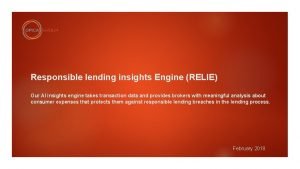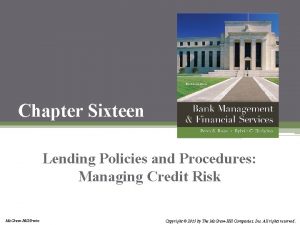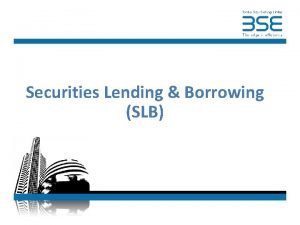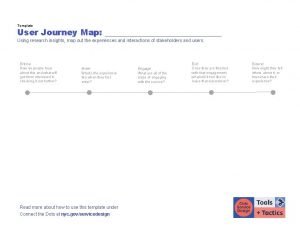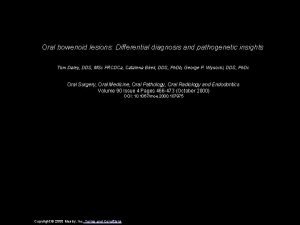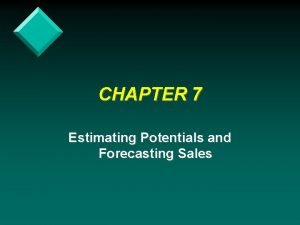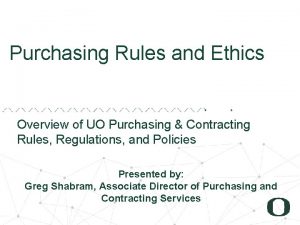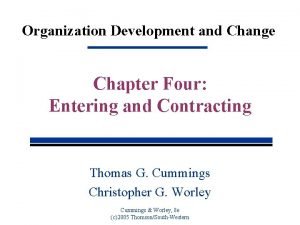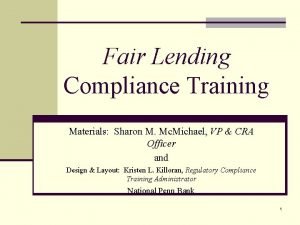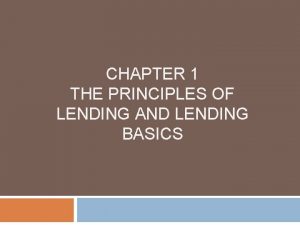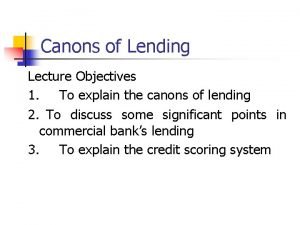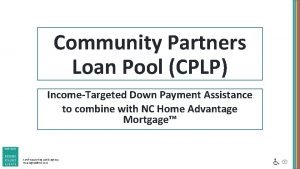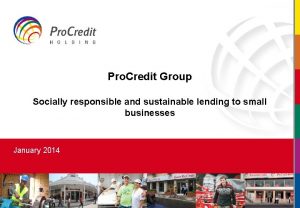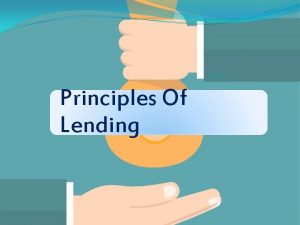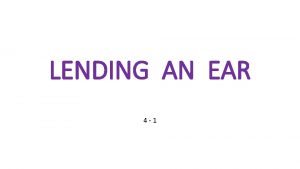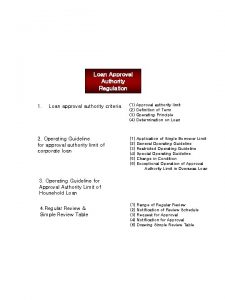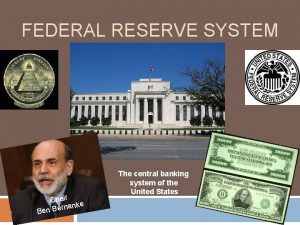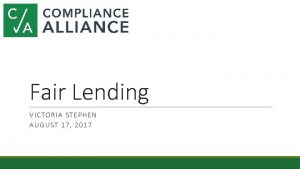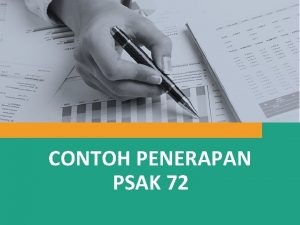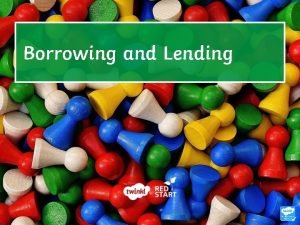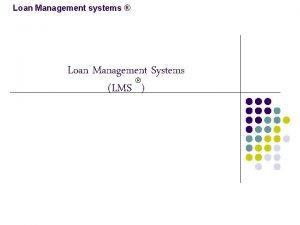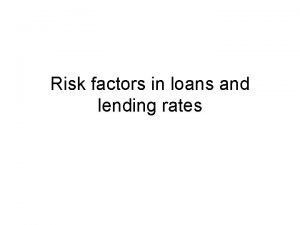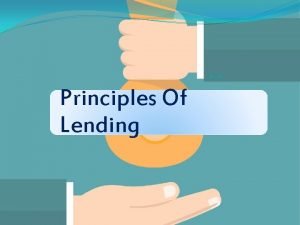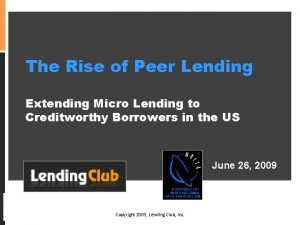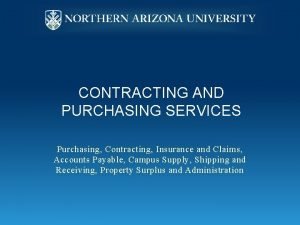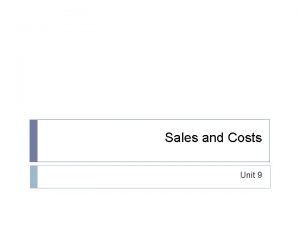On Loan Sales Loan Contracting and Lending Relationships








































- Slides: 40

On Loan Sales, Loan Contracting, and Lending Relationships Steven Drucker Columbia Business School & Manju Puri Fuqua School of Business, Duke University October 2006

Motivation Loan selling is important for banks and the economy § Trading Volume: $154. 8 billion in 2004 vs. $8. 0 billion in 1991 § Diversification; Comply with Risk Adequacy Regulations § Allows Origination even when Funding Constrained Loan Selling Fundamentally Alters Lending Screening, Monitoring, Funding Upfront Fees Borrower Loan Seller Lender Interest Upfront Fees, st Payments Monitorin g, Fundi ng Loan Buyer 2

Main Issues Loan Sales Separate Origination from Funding Agency Problems § Moral Hazard (Pennacchi 1988; Gorton & Pennacchi 1995) § Adverse Selection § How do banks overcome these problems? Loan Contracting Access to Loans and Lending Relationships § Harm? Reduce interaction that is critical to benefits (Diamond 1991) § Help? Increased Capital From Non Banks Risk Management Flexibility in Future Loan Origination 3

Outline q Data, Sample Selection, and Descriptive Statistics q Loan Sales and Loan Contracting § Secondary Market Sales and Covenants § Covenants and Agency Problems q Loan Sales, Access to Loans, and Lending Relationships § Current Loans § Lending Relationships and Future Loans q Other Issues and Summary 4

Data and Sample Selection Sample Period: 1999 2004 Data from four sources with some data matched by hand § Loans & Lending Relationships (LPC Deal. Scan) § Identify Traded Loans (LSTA Mark to Market Pricing) § Borrower Financial Characteristics (Compustat) § Equity Market Data (CRSP) Sample Sizes (link) 5

Sold Loans and Information Asymmetry Sold Borrowers are larger and rated (link) § Information Transparency Sold Loans are Term Loans instead of Credit Lines § Monitoring Lead Lender on Sold Loan has Higher Market Share § Reputation 6

Outline q Data, Sample Selection, and Descriptive Statistics q Loan Sales and Loan Contracting § Secondary Market Sales and Covenants § Covenants and Agency Problems q Loan Sales, Access to Loans, and Lending Relationships § Current Loans § Lending Relationships and Future Loans q Other Issues and Summary 7

Secondary Market Sales and Covenants Selling Loans Can Induce Agency Problems Screening Upfront Fees Borrower Loan Seller Interest Paymen ts Monitorin g, Fundi ng Loan Buyer Financial Covenants Reduce Reliance on Seller’s Information § Monitoring Mechanism § Buyer Exercises Control When Firm Performs Poorly 8

Secondary Market Sales and Covenants Univariate Relationship Between Covenants and Loan Sales Multivariate Logit Model (Table 4) (link) § Dependent Variable: Indicator for Loan is Sold Key Independent Variables § # of Financial Covenants (+) § Net Worth Slack ( ) Control Variables § Lender Market Share; Borrower and Loan Variables 9

Table 4: Probability of Selling Loans 10

Secondary Market Sales and Covenants Changes in Predicted Probabilities (link) § One Std. Dev Change Around the Mean (t stats in parentheses) Key Results: § More Covenants Increases Probability of Loan Sale § Tighter Covenants Increases Probability of Loan Sale 11

Are Loans Structured to Sell to Others? Sold Loans are Nearly Always Syndicated (Primary Market) Not all Syndicated Loans are Sold Close to the Loan Origination Date (link) 12

Are Loans Structured to Sell to Others? Banks are not selling poorly performing loans Distribution of Initial Sale Prices Performance of Sold Borrowers: Origination to Sale 13

Covenants and Agency Problems Syndication: Primary Market Sales Additional Mechanisms for Mitigating Agency Problems § Hold Larger Piece of Loan (e. g. Dennis & Mullineaux 2000) § Syndicate Structure and Composition (Lee & Mullineaux 2004; Sufi 2005) § Expect Smaller Agency Problems Empirical Prediction § # of Covenants / Tighter Covenants have LESS influence on probability of loan syndication (compared to loan sale) Empirical Model: Probability of Syndication (Table 5) link) ( 14

Primary Market Sales and Covenants Changes in Predicted Probabilities (link) § One Std. Dev Change Around the Mean (t stats in parentheses) Compared to Secondary Market Sales: § More Covenants – Similar Effect § Tighter Covenants – Weaker Effect Covenants play less of a role in the primary market 15

Covenants and Agency Problems Lower Reputation Lender Increased Agency Problems § Gorton & Haubrich (1987); Pichler & Wilhelm (2001) Empirical Prediction § Low Reputation Lender # of Covenants / Tighter Covenants have LARGER influence on probability of loan selling Modify Loan Sales Model (Table 6) (link) § Interact Reputation Indicators with Covenant Variables 16

Lender Reputation Changes in Predicted Probabilities of Selling Loans (link) § One Std. Dev Change Around the Mean (t stats in parentheses) Key Result: § Tighter Covenants Increases Probability of Loan Sale when lenders have LOW REPUTATION Evidence is consistent with agency view 17

Outline q Data, Sample Selection, and Descriptive Statistics q Loan Sales and Loan Contracting § Secondary Market Sales and Covenants § Covenants and Agency Problems q Loan Sales, Access to Loans, and Lending Relationships § Current Loans § Lending Relationships and Future Loans q Other Issues and Summary 18

Loan Sales and Access to Loans Restrictive Covenants / Loan Sales Impose Costs on Borrowers § Managerial Flexibility § Additional Lenders Renegotiation Costs Why do Borrowers Agree to Restrictive Covenants / Loan Sales? EXPLORE: Access to Private Debt Capital § Anecdotal Evidence Suggests that Loan Buyers are Usually Non. Banks Additional Capital 19

Current Loans Key Results § Sold Borrowers are Growing and Debt dependent § Sold Year: Increase in Private Debt Issuance 20

Loan Sales and Lending Relationships Loan Sales Separate Origination from Monitoring / Funding Screening Upfront Fees Borrower Loan Seller Interest Paymen ts Monitorin g, Fundi ng Loan Buyer Harm Access to Future Credit / Relationships? § Reduced Ongoing Interaction (Diamond 1991; Boot & Thakor 1994) Help Access to Future Credit / Relationships? § New Source of Capital § Reduced Exposure to Individual Borrowers Flexibility 21

Loan Sales and Lending Relationships Univariate Results (Table 9) Sold Borrowers are § More Likely to Receive Future Loans § More Likely to Continue Lending Relationships 22

Loan Sales and Lending Relationships Explore: Risk Management Lending Flexibility § Do Loan Sales Increase Relationship Durability for High Risk Firms? High Reputation Lenders? Univariate Results (Table 9): Conditional on Receiving Another Loan, % that Keep Same Lead Bank 23

Loan Sales and Lending Relationships Nested Logit Model (Table 10) Don’t Borrow Again (link) Borrow Again Keep Lender Don’t Keep Lender Independent Variables: “Borrow Again” § Borrower Characteristics; Year Fixed Effects Independent Variables: “Borrow Again” and “Keep Lender” § Loan is Sold; Lender Market Share; Prior Lending Relationship 24

Outline q Data, Sample Selection, and Descriptive Statistics q Loan Sales and Loan Contracting § Secondary Market Sales and Covenants § Covenants and Agency Problems q Loan Sales, Access to Loans, and Lending Relationships § Current Loans § Lending Relationships and Future Loans q Other Issues and Summary 26

Other Issues Timing of Loan Sales § Limit Analysis to Loans with quotes within 3/6/12 months of origination Loan Trades v. Loan Quotes § Limit Analysis to Loans with Multiple Market Makers Seniority / Secured Lending § Seniority: Almost all loans are senior or missing classification § Secured loans are more likely to be sold; covenant results still hold 27

Summary Loan Selling Separates Origination and Funding § Agency Problems Loan Contracting § Access to Loans and Lending Relationships Sold Loans Have Additional, Tighter Covenants § Consistent With Covenants Used When Agency Problems Are Larger Sold Borrowers: Debt Dependent, Receive Additional Private Debt § Benefit to Offset Costs of Restrictive Covenants / Loan Sales Sold Borrowers get Future Loans, Keep Lending Relationships § Impact Strongest for High Risk Borrowers § Additional Capital and Flexibility for Lenders 28

Tables 29

Table 1: Loan Sample Summary Statistics (link) 30

Table 2: Univariate Analysis- Sold Loans vs. Not Sold Loans ) 31

Table 2 (continued): Univariate Analysis - Sold Loans vs. Not Sold Loans (link) 32

Table 3: Sold Loans – Timing, Pricing, and Performance ) (link) 33

Table 4: Probability of Selling Loans (link) 34

Table 5: Probability of Loan Syndication (link) 35

Table 6: Probability of Selling Loans - Lender Reputation (link) 36

Table 7: Probability of Selling Loans – Borrower Risk (link) 37

Table 8: Loan Sales and Debt Capital 38

Table 9: Univariate Analysis - Keeping the Same Lender 39

Table 10: Nested Logit Models- Keeping the Same Lender 40

Table 10 (continued): Nested Logit Models – Borrowing Again (link) 41
 Sales force organizational structure
Sales force organizational structure Difference between sales letter and sales promotion letter
Difference between sales letter and sales promotion letter Salesforce organization structure
Salesforce organization structure Sales territories and sales quotas
Sales territories and sales quotas Relie expense verification platform
Relie expense verification platform An institution for receiving, keeping and lending money
An institution for receiving, keeping and lending money Lending policies and procedures managing credit risk
Lending policies and procedures managing credit risk Securities lending and borrowing example
Securities lending and borrowing example Queensbridge map
Queensbridge map Relie responsible lending and insights engine
Relie responsible lending and insights engine Relie responsible lending and insights engine
Relie responsible lending and insights engine Relie responsible lending and insights engine
Relie responsible lending and insights engine Relie responsible lending and insights engine
Relie responsible lending and insights engine Sales force composite
Sales force composite Uo purchasing and contracting
Uo purchasing and contracting Ctip for acquisition and contracting professionals
Ctip for acquisition and contracting professionals Interpersonal process issues in entering and contracting
Interpersonal process issues in entering and contracting Exblowra trading and contracting
Exblowra trading and contracting Illegal money lending team
Illegal money lending team Sla servicing student loans
Sla servicing student loans Fair lending compliance training
Fair lending compliance training Principles of lending
Principles of lending Canons of lending
Canons of lending Community partners loan pool
Community partners loan pool Socially responsible lending
Socially responsible lending Principle of sound lending
Principle of sound lending Life below zero: bank lending under negative policy rates
Life below zero: bank lending under negative policy rates Jblm lending closet
Jblm lending closet Principles of lending
Principles of lending Alejandro labrador
Alejandro labrador Forms of international lending
Forms of international lending Rumus blr
Rumus blr Lending authority definition
Lending authority definition Fractional reserve lending
Fractional reserve lending Ffiec fair lending examination procedures appendix
Ffiec fair lending examination procedures appendix Khushhali bank karobar loan
Khushhali bank karobar loan Teejan uae
Teejan uae Contract matrix template
Contract matrix template Contracting state meaning in aviation
Contracting state meaning in aviation Nrcg contracting for fire
Nrcg contracting for fire Contoh soal psak 72
Contoh soal psak 72




